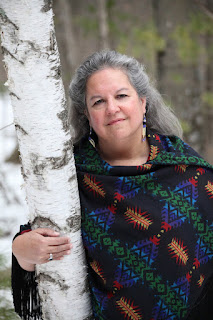 Braiding Sweetgrass: Indigenous Wisdom, Scientific Knowledge and the Teachings of Plants by Robin Wall Kimmerer
Braiding Sweetgrass: Indigenous Wisdom, Scientific Knowledge and the Teachings of Plants by Robin Wall KimmererMy rating: 5 of 5 stars
Robin Wall Kimmerer says of humans: “Our job is to remember, to heal the relationship to the land,” synthesizing Western, ecological and Indigenous sciences where “land, animals and plants work together…are one in flourishing.” Abandon or completely retool the Western paradigm of a “one way flow from nature to humans” in order to return to “restoration” “re-storyation,” reacculturation that “envisions embodied reciprocity” and “access and use as part of a shared cultural landscape.”
“The danger of monocultures is that they are inherently unstable. Human exceptionalism is at the root of much white exceptionalism, ‘othering’ and diminishment,” a false sense of being “outside of nature,” outside of “land, peoples and ‘natural resources’” in a way that denies the value and “animacy of us all.” “Through an Indigenous lens, land is our identity, our sustainer, home for MORE than human relatives and ancestors.” Land as Mother Earth or Turtle Island is “healer…inspirited, sacred…connection.”
By stepping out of the “colonial framework,” “all lands here are Indigenous lands,” where “only two percent of these original homelands” are owned and managed by Indigenous people. We need to ask ourselves how we can “enact (th)our moral responsibility to the land,” “focus not on the offense” or “wrongdoing” but on an “illness to be healed;” working on “rematriation, restorative justice,” as “partners, combining our gifts and responsibilities.” “Conserve the remnants AND heal the damage.”
Sponsored by the Muwekma Ohlone Preservation Foundation in partnership with Peninsula Open Space Trust, Kimmerer planned to speak about “a roadmap for how people can come into relationship and care for the land where they live, honoring the past and planning for a sustainable future,” but she and Greg Sarris, author and Chaiperson for the Federated Indians of Graton Rancheria, both broadened it to a “rethinking how all of us can be home and safe again, and where, in fact, we see that all of life and all of culture is sacred and worthy of profound respect.”
“Sustainability” as in “dense plantations of young Doug Fir like sections of manicured lawn” is not “rough textured and multihued from a distance, the signature of the (multilayered and diversified, healthy) old-growth forest, the forest that used to be.”
“In five hundred years we exterminated old-growth cultures and old-growth ecosystems, replacing them with opportunistic culture…. If we are looking for models of self-sustaining communities, we need look no further than an old-growth forest. Or the old-growth cultures they raised in symbiosis with them.”
Another systemic conundrum, brought about by human heedlessness, truth be told.
In Braiding Sweetgrass: Indigenous Wisdom, Scientific Knowledge and the Teachings of Plants, Kimmerer tells stories of her life as a Mom, and as an Associate Professor of Environmental and Forest Biology of Potawatomi heritage, tells stories that move us toward understanding what a respectful, reciprocal relationship with the “animate” “beings” (of ourselves, Mother Earth, communities and the cosmos) would be like.
"The most important thing each of us can know is our unique gift and how to use it in the world. Individuality is cherished and nurtured, because, in order for the whole to flourish, each of us has to be strong in who we are and carry our gifts with conviction, so they can be shared... (The way of the Three Sisters is a) basic teaching of our people... provides a visible manifestation of what a community can become when members understand and share thour gifts."
"The most important thing each of us can know is our unique gift and how to use it in the world. Individuality is cherished and nurtured, because, in order for the whole to flourish, each of us has to be strong in who we are and carry our gifts with conviction, so they can be shared... (The way of the Three Sisters is a) basic teaching of our people... provides a visible manifestation of what a community can become when members understand and share thour gifts."
We haven’t quite got this ecology thing figured out yet,
do we?
In 1997, in News from Native California, Gail Kulhavy, Project Manager for the California Gold Discovery to Statehood Sesquicentennial, wrote in “A Time to Share,” “Among non-Indians, what the California Indian people went through hasn’t been told, hasn’t been learned, and hasn’t had a forum,” but since then, Indians could “share a history garnered from history, experience, elders, legend, and stories,”
Kulhavy wrote also that in sharing stories now, “This is a time of truth – not to affect blame, but to inspire change.” Now, doesn’t that “ring a bell?”
View all my reviews


